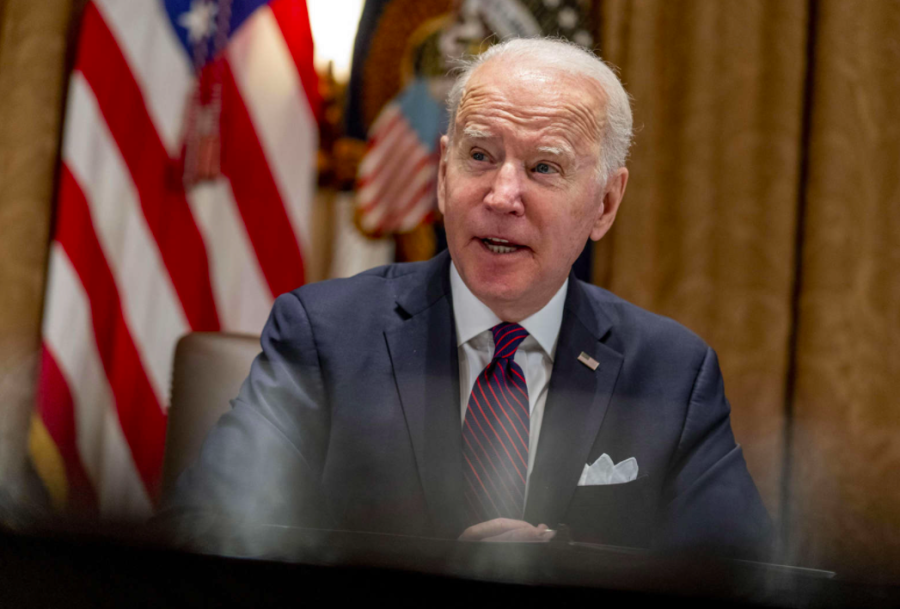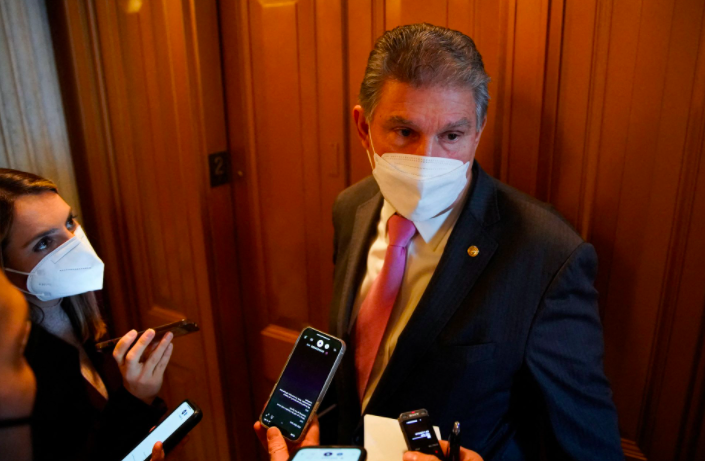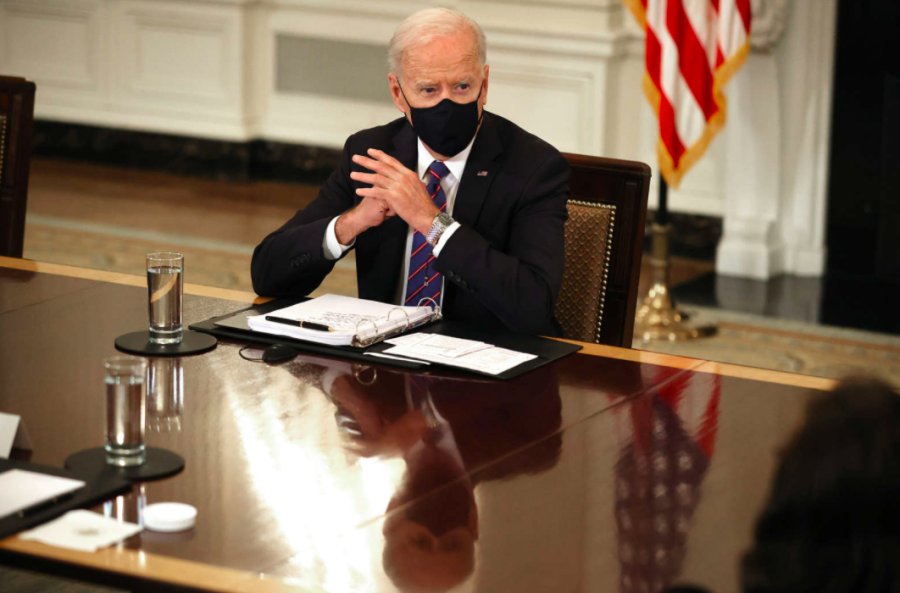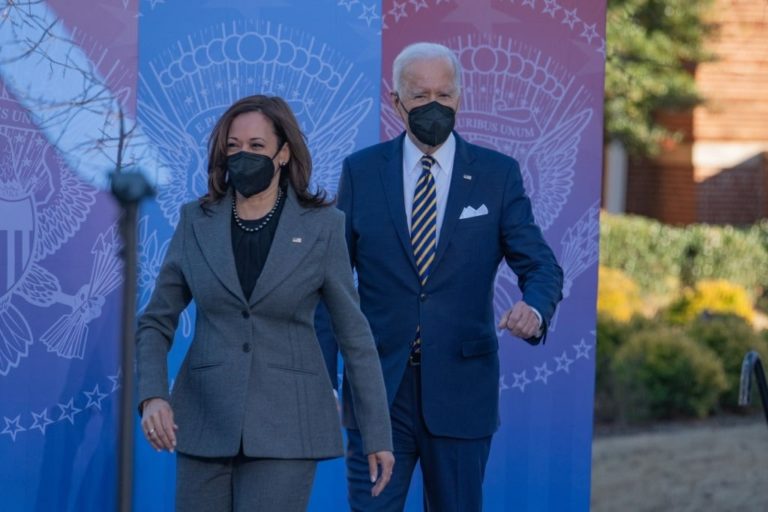Biden Administration Faces a Range of Challenges
January 20, 2022
One year into President Biden’s administration, he is at an inflection point. The President and the Democratic-controlled Congress have had undeniable success on issues like the COVID-19 vaccine rollout, dropping unemployment numbers, liberal executive actions, and the passage of legislative measures like his COVID-19 rescue plan and bipartisan infrastructure deal. However, a combination of uncontrollable circumstances, from the blossoming of new variants of COVID-19 to the climbing of prices due to inflation and a remaining congressional agenda that is stalled at the behest of two “moderate” Democratic Senators has brought the President to a defining moment in his presidency in the midst of a variety of rapidly spiraling domestic and foreign situations.
The COVID-19 Pandemic
The President faces the most challenging part of the COVID-19 public health crisis yet, as the Omicron variant rapidly spreads across the country, bringing an already nervous nation to the edge. While the President can find comfort in the fact that the surge seems to be quickly subsiding in some of the first-affected and most heavily vaccinated populations, in part thanks to the smooth rollout of vaccinations and boosters, the case counts have spiked to their highest levels in the entirety of the pandemic. This has led the President to authorize one billion at-home testing kits and a large number of good-quality masks to be sent out to every American by mail. These decisions have been endorsed by the likes of Senator Bernie Sanders of Vermont amidst a squeeze on the medical system. The effect of these measures are yet to be seen as are the political implications of the Omicron variant. Before these recent announcements, a series of vaccine mandates were seen as some of the President’s most powerful tools in fighting the pandemic. However, the conservative supreme court recently struck down the mandate on large businesses, while upholding the mandate on healthcare workers. While the ruling was definitely a blow for the administration, the administration has vowed to keep pushing ahead in their vaccination efforts. In a best-case scenario for the President and the country, the virus sees a crash in the coming weeks followed by relative stability. This plays into the fact that as goes the virus, so goes public sentiment. The President’s approval rating in particular has been quite in tune with the rise of new variants.
The Economy
The President has pushed positive economic numbers on both unemployment and wages as indicators of a strong and resurgent economy. However, higher prices on items like gasoline and food due to inflation and supply chain issues have been a top line of attack from his opponents. As a result, the President has started to roll out measures intended to combat price hikes, such as tapping into the Strategic Petroleum Reserve to help reduce the price of gasoline and announcing measures to support small farmers, a way to combat the higher meat prices which some economists suspect come from price-gouging by large agricultural corporations. Though the most recent report on inflation showed prices continuing to climb overall, the administration took time to highlight the fact that the report showed a slowing in the overall rate of inflation, a sign of potentially better times ahead. There is a growing consensus among political analysts that inflation concerns will play a critical role in the president’s favorability and how the democratic party fares in the midterm elections, because of how close the affected prices, like those of gasoline, milk, and meat, are to American sentiment and life, even if the President himself is not to blame. If inflation continues to climb, the President will likely have to withstand an unrelenting attack from Republicans going into the midterms, though many Democrats have touted improving signs in gas prices as a beacon of optimism that the concerns will subside by Summer.
Congressional Agenda
Since the President’s major victories on COVID relief and infrastructure in Congress last year, he has attempted to muscle through the passage of his signature care and climate package as well as a voting rights package. These bills have run up against hard obstacles in Senators Joe Manchin of West Virginia and Kyrsten Sinema of Arizona, the two most conservative Democrats in the Senate. The President’s pushes on both measures come amidst a growing sense of urgency. The care and climate package, known as the Build Back Better act, is increasingly imperative in the context of spreading of climate hazards, like wildfires and hurricanes, as well as a widespread lack of affordable health care and child care exacerbated by the pandemic.
The duo of Senators, Manchin, and Sinema, also opposed altering the filibuster, a legislative firewall that prevents any legislation from passing without 60 votes, effectively dealing a death blow to voting rights legislation such as the Freedom to Vote Act, the main legislation that the President is trying to pass related to voting rights. Senators Manchin, Sinema, and Susan Collins, a Republican from Maine, have led discussions about a potential bipartisan voting rights package centered around reform of the Electoral Count Act, which former President Trump used last year in his falsely-based attempts to try to overturn the election, culminating with the January 6th insurrection.
The package could also include provisions from the Democrats’ bill, though the negotiations are still in the early stages. However, Democrats have been clear that, regardless of the specifics, they need to see some progress on the front of voting rights, because events like the insurrection showed the stakes of refusing to aid processes like the right to a fair vote, and that failing to do anything would ultimately be playing into the hands of those who want to erode democracy, both domestically and foreign. As for the Build Back Better act, Senator Manchin dealt it a blow in late December, when he announced that he could not support the bill in its current form. Since then, negotiations have halted as the Senate discussed voting rights, though they are expected to restart soon, centered around achieving reforms that Manchin has already explicitly supported, like expanding the Affordable Care act, establishing universal childcare and pre-k, and an already negotiated major climate package. Many Democrats would likely push for immigration measures to be added into any package, though their fate would be uncertain in the face of Manchin’s uncertainty and parliamentary obstacles. Moreover, there has been a growing drumbeat that action on immigration be attempted, particularly among Hispanic Democrats in congress, given that many saw the issue as a prime motivator for the Democratic base, much of which is Hispanic, in states like Arizona, which narrowly flipped to President Biden’s column last year. Senator Ben Ray Lujan, a Democrat from New Mexico who has been heavily involved in these discussions, said that the fight for such provisions, like protections for undocumented immigrants, will continue this spring.
Executive Actions
There are areas of the President’s agenda, like police and gun reform, that simply will never have a chance of passing through Congress, either because of the filibuster or a lack of support within Congress. Reports suggest that the President is planning several executive orders at the start of February aimed at advancing his goals on police reform, many of which are in the currently-stalled George Floyd Justice in Policing act. Additionally, the President has sent out a series of executive orders on gun reform, as any hope that such legislation would pass through Congress has died. The orders are aimed at reducing the number of so-called ghost guns, or guns without registries, that are currently in circulation. On the issue of immigration, which has also been stalled, at least for now, in Congress, the President has issued a series of executive orders aimed at making the system more humane, after the former administration notoriously separated children from their families in a move that many called cruel and inhumane. President Biden’s orders have included establishing a task force to reunite these families, and to provide as much protection to young undocumented immigrants known as “dreamers” as possible through executive mechanisms. As for voting rights, the President issued an executive order last spring that essentially ordered all federal agencies to do as much as possible in their jurisdictions to advance the right to vote, absent congressional action.
Foreign Policy
President Biden is, at the moment, facing what could become one of the biggest foreign policy stories of his presidency, a Russian invasion of Ukraine. Though the invasion has not officially started, President Vladimir Putin of Russia has reportedly sent nearly 100,000 troops onto the country’s border, and diplomatic efforts aimed to stop the aggression, while coordinated among America and its allies, have so far proved relatively fruitless. The question now is how America would respond to such aggression, such as if the nation would consider significant military aid to Ukraine, or if the backlash would rather be centered around massive economic sanctions or a combination of the two. Looming even larger is the question of whether Putin and Russia would react to such measures with cyberattacks aimed at American infrastructure, which could prove critical. Over the past years, such cyberattacks have ramped up, including one aimed at a large pipeline in the Eastern United States, which crippled much of the region for days, as officials managed to get the situation under control. President Biden has warned Putin in the past that such attacks are unacceptable, and that even more severe consequences would occur if such a red line were to be crossed.
This face-off comes after a several-pronged year one in foreign policy. The main goal of the administration’s plan was to regain credibility on the world stage, and the President worked to achieve this goal by engaging in a series of summits and meetings with the leaders of top democracies worldwide and by visiting and personally meeting many European heads of state on trips last summer and fall. Vice President Kamala Harris and Secretary of State Antony Blinken also made such trips, the most noted of which was Vice President Harris’ visit to France last fall, in which she reportedly impressed French President Emmanuel Macron so much with her expertise of geopolitical issues that the president has offered effusive praise for her in his discussion with other European leaders. The administration has also attempted to pile the pressure on top autocracies, like China and Russia, with a strategy aimed at building up a modern infrastructure stockpile similar to that of nations like China, which have greatly surpassed the United States in their investments in areas like airport and electric car infrastructure, though the administration argues that the situation has started to turn back towards the United States after the passage of the Bipartisan Infrastructure Law late last year. The most memorable foreign policy move thus far, however, has been the administration’s move to withdraw troops from Afghanistan, ending the nation’s longest-ever war after around two decades of deadly fighting. Though the withdrawal was criticized as shaky and dangerous, the President has stood by his decision, saying that he could not bear to see any more Americans fight and die under his watch.
Conclusion
All of these circumstances have piled up to one of the largest political traffic jams in recent memory, filled with challenges within and beyond the nation’s frontiers and coming at a critical time ahead of this year’s midterm elections. The question now is whether the President will be able to pass some congressional goals and if American life will be able to improve regarding issues like the pandemic and inflation by summer. This could likely spell good fortune for the President and his congressional majorities later this year in the upcoming midterm elections.
On January 19, 2022, President Biden held a press conference at the White House, in which he outlined much of his message going into the midterm election season. He emphasized that while he would keep fighting to do everything in his power to help ease the continuing burdens of COVID-19 and inflation on the American people, there has been significant progress, given the impressive roll-out of vaccines and better unemployment rates thanks to the American Rescue Plan. He also touted other legislative wins, like the Bipartisan Infrastructure Law, and stood by his decision to withdraw troops from Afghanistan. On the issue of Russia and Ukraine, he warned that there would be dire consequences on Putin’s economy if he were to start a full-scale invasion. As for the rest of President Biden’s agenda, he opened the door to a scaled-down or split-up version of the Build Back Better bill, while opening the door to a potential bipartisan solution on voting rights. Lastly, with his eyes set on the 2024 presidential election, the President made it extremely clear that he would be keeping Vice President Kamala Harris on his ticket, and that he has been very satisfied with her performance thus far.






